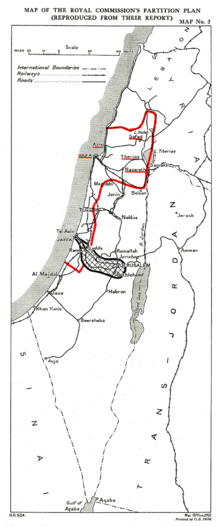
Back لجنة بيل Arabic Peelova komise Czech Peel-kommissionen Danish Peel-Kommission German Peel-komisiono Esperanto Comisión Peel Spanish Peelin komitea Finnish Commission Peel French ועדת פיל HE Komisi Peel ID
| Report of the Palestine Royal Commission | |
|---|---|
 Peel Commission Partition Plan, July 1937. Areas enclosed within the red line were part of the proposed Jewish state. The black line with hatched area represents an "enclave" (or "corridor") that was proposed as an international zone to remain under British control and administration, in recognition of Jerusalem's religious and historical importance to Christians, Jews, and Muslims. | |
| Created | July 1937 |
| Purpose | Investigation of the causes of the 1936 Arab revolt in Palestine |
The Peel Commission, formally known as the Palestine Royal Commission, was a British Royal Commission of Inquiry, headed by Lord Peel, appointed in 1936 to investigate the causes of conflict in Mandatory Palestine, which was administered by the United Kingdom, following a six-month-long Arab general strike.
On 7 July 1937, the commission published a report that, for the first time, stated that the League of Nations Mandate had become unworkable and recommended partition.[1] The British cabinet endorsed the Partition plan in principle, but requested more information.[2] Following the publication, in 1938 the Woodhead Commission was appointed to examine it in detail and recommend an actual partition plan.
The Arabs opposed the partition plan and condemned it unanimously.[3] The Arab Higher Committee opposed the idea of a Jewish state[4] and called for an independent state of Palestine, "with protection of all legitimate Jewish and other minority rights and safeguarding of reasonable British interests".[5] They also demanded cessation of all Jewish immigration and land purchase.[4] They argued that the creation of a Jewish state and lack of independent Palestine was a betrayal of the word given by Britain.[2][6]
The Zionist leadership was bitterly divided over the plan.[4] In a resolution adopted at the 1937 Zionist Congress, the delegates rejected the specific partition plan. Yet the principle of partition is generally thought to have been "accepted" or "not rejected outright" by any major faction: the delegates empowered the leadership to pursue future negotiations.[4][7][8][9] The Jewish Agency Council later attached a request that a conference be convened to explore a peaceful settlement in terms of an undivided Palestine.[4] According to Benny Morris, Ben-Gurion and Weizmann saw it "as a stepping stone to some further expansion and the eventual takeover of the whole of Palestine".[4][10]
- ^ Cite error: The named reference
avalonwas invoked but never defined (see the help page). - ^ a b Mandated Landscape: British Imperial Rule in Palestine 1929–1948
- ^ Qumsiyeh, Mazin B. (2011). Popular Resistance in Palestine: A History of Hope and Empowerment. Pluto Press. p. 85. doi:10.2307/j.ctt183p294. ISBN 9780745330693. OCLC 730502342.
- ^ a b c d e f Cite error: The named reference
Podehwas invoked but never defined (see the help page). - ^ Bose, Sumantra (30 June 2009). Contested Lands. Harvard University Press. p. 223. ISBN 978-0-674-02856-2.
- ^ Cite error: The named reference
jstor25642368was invoked but never defined (see the help page). - ^ Itzhak Galnoor, Partition of Palestine, The: Decision Crossroads in the Zionist Movement, State University of New York Press 2012 p. 208.
- ^ Allan Gerson, Israel, the West Bank and International Law, Frank Cass 1978, pp. 87–88, n. 33.
- ^ Herbert Druks, The Uncertain Friendship: The U.S. and Israel from Roosevelt to Kennedy, ABC-Clio/Greenwood Publishing, 2001 p. 33.
- ^ Benny Morris, Righteous Victims: A History of the Zionist–Arab Conflict, 1881–2001, Vintage Books 2001 pp. 136–137
© MMXXIII Rich X Search. We shall prevail. All rights reserved. Rich X Search